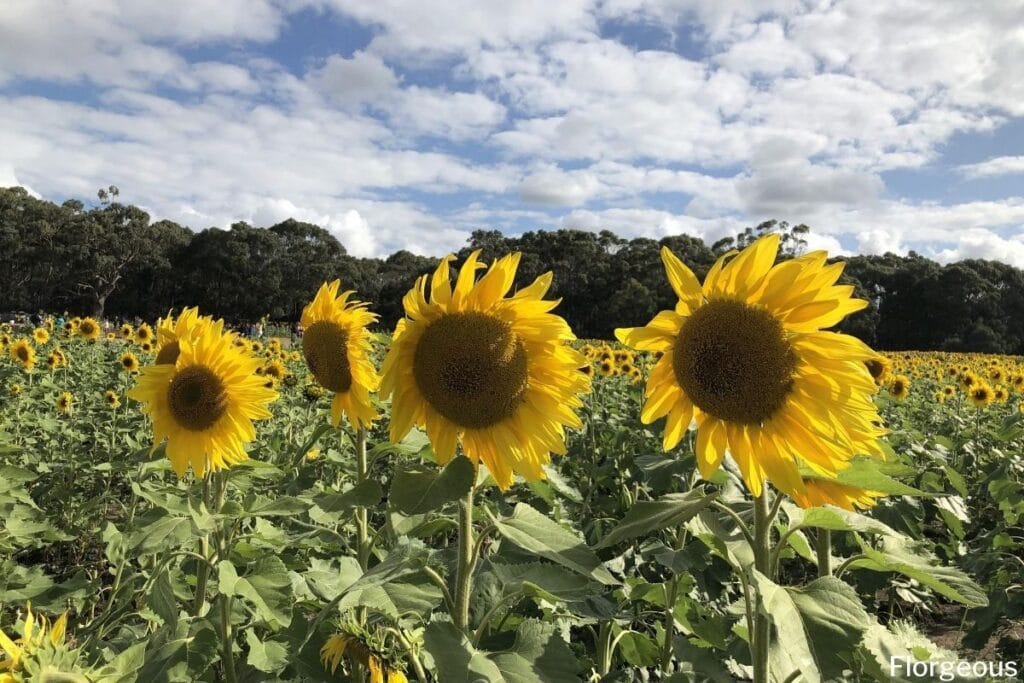Sunflowers are easily one of the most recognized flowers worldwide, although they are native to the Americas. They have been used for oil, food, dye, and even medicine throughout hundreds of years.
- Facts about Sunflowers
- Common Varieties of Sunflowers
- Golden Bear Sunflower
- Italian White Sunflower
- Ring of Fire Sunflower
- Early Back Heart Sunflower
- Moulin Rouge Sunflower
- Elf Sunflower
- Choco Sun Sunflower
- Strawberry Blonde Sunflower
- Velvet Queen Sunflower
- Sunbright Sunflower
- Sunrich Lime Sunflower
- Russian Giant Sunflower
- Helios Flame Sunflower
- Star Sunflower
- ProCut Peach Sunflower
- Evening Sun Sunflower
- Dwarf sunflowers
- How To Grow and Care for Sunflowers
- FAQs
In fact, sunflowers have been so important to indigenous communities, that they were often paired alongside corn, squash, and beans, in an agricultural method referred to as ‘’the three sisters’ method’’. In this case, sunflowers were the fourth sisters, and their role was to protect the other three sisters.
In addition, sunflowers have been seen as a symbol of the solar deity in many diverse cultures, which makes sense. Every time you see a sunflower plant, it immediately perks up your mood and brightens up the place!
Continue reading if you would like to know more interesting facts about sunflowers: from its necessary basic information, to how to grow and take care of them, to the different types of this flower, this article will explain everything you need to know before planting sunflowers in your garden!

Facts about Sunflowers
Sunflowers are also scientifically known as Helianthus annuus, and they form part of the Asteraceae family of plants.
They are a sizable annual plant that provides edible seeds and one of the most used oil types in the world.
It is often used as livestock forage, and, at the same time, wild birds’ feed. These flowers can be found in many gardens as an ornamental plant, although you can place them even inside your home in a vase!

You can observe the seeds right in the center of the sunflower. This area is made out of tiny blossoms, which are great for attracting pollinators, such as bees. This is particularly good because sunflowers help bees remain healthy. As we all know, bees are among the most important pollinators that work towards the preservation of plant biodiversity.
These seeds have male and female sex organs, which allows them to continue to produce more seeds; in other words, sunflowers will self-pollinate if necessary.
When the conditions are right, these seeds germinate, sprouting into new sunflower plants. And when sunflowers bloom, their vibrant yellow petals and sweet, woody scent fill the summer air.
The inside of the flower is made of smaller flowers. They are one of the tallest flowers on earth; their height could reach 5 to 12 feet tall, and they will only ever need around six months to develop fully.
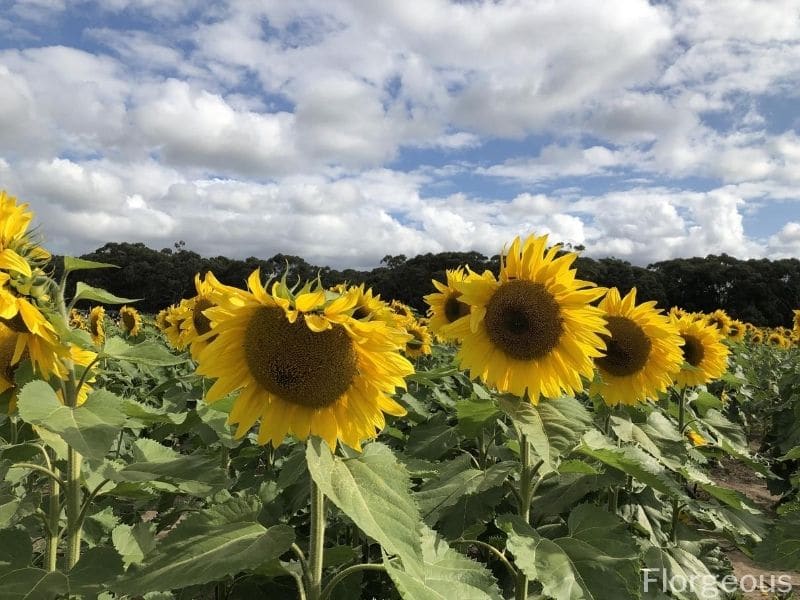
Sunflowers are known for removing heavy metal toxins, so they can help the soil become healthy. Thanks to this characteristic, sunflowers have been planted in places like Fukushima and Chernobyl, in order for them to act as a decontaminator of all the chemicals that were found in those areas after the world’s worst environmental disasters.
Common Varieties of Sunflowers
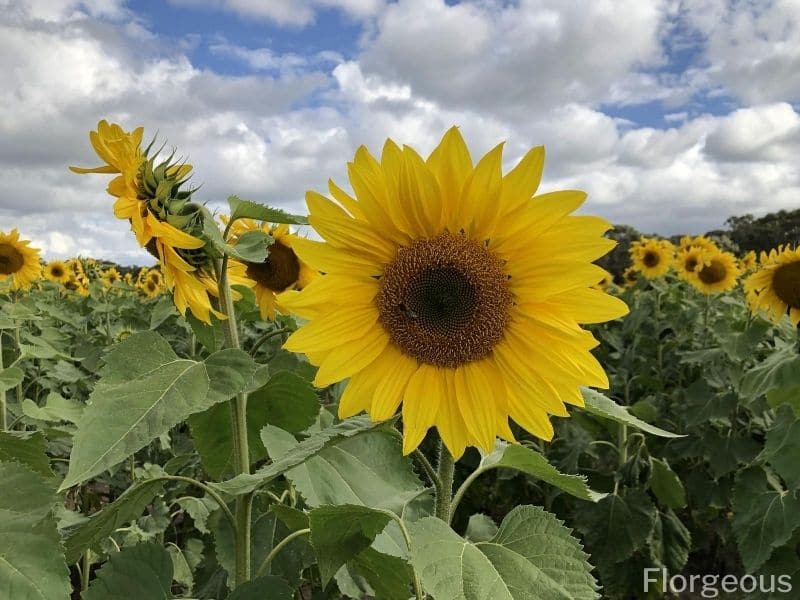
Many individuals think sunflowers are only yellow! In reality, you can find red, orange, and an almost violet type of sunflower.
Sunflowers can be grown as an ornamental plant in your house! They are relatively easy to grow, and they can develop in a short period of time; thus, you will be able to see the results quickly.
Here are some of the types of sunflowers you can grow in your garden:
Golden Bear Sunflower
This type of sunflower is very similar to zinnias; however, they are taller (as they can reach up to ten feet in height), and they have more prominent blooms. In fact, these bright blooms tend to have thousands of petals!
They take their time to reach full maturity, which they will do six to eight months before they are planted. Golden bear sunflowers need plenty of space, water, and, of course, sunlight!
Italian White Sunflower
This plant can grow up to five feet tall. Pollinators love them, so prepare to bring them all to your garden! These petals are not entirely white though, they are more of a cream color, although they are gorgeous indeed!
Ring of Fire Sunflower

This sunflower resembles a gazania, mainly because of its structure and colors. They are bicolor and will undoubtedly stand out in any garden! Sunrays will not affect its color either; so, don’t worry about planting this flower.
Early Back Heart Sunflower
If you thought sunflowers grew quickly, wait until you plant this type! They will reach maturity in less than 60 days – talk about growing fast! The early back heart sunflower has golden petals, which are very bright, and they could quickly grow up to six feet in height.
The early back heart needs lots of sun, a well-drained soil, and plenty of water to thrive.
Moulin Rouge Sunflower

What an exciting name! This type of perennial sunflowers has deep red petals. Don’t worry, though; sunrays will not fade them away. They are also pollen-free, so you won’t attract many pollinators if you plant this type of sunflower. They can grow up to eight feet in height!
Elf Sunflower
As its name suggests, elf sunflowers are smaller plants in comparison to ‘’normal’’ sunflowers. If you have children (or even grandchildren), why not reserve a section of your garden to plant and take care of these sunflowers? They can reach up to 14 inches in height, and they will grow in less than six months.
Choco Sun Sunflower
It can grow up to 12 inches in height. They tend to mature fast; in less than 11 weeks, you will be able to see your choco sunflowers on full display.
Strawberry Blonde Sunflower
One of the most stunning sunflowers on earth! This flower has an interesting mixture of colors: it’s not red, but it’s not pink either, it’s a combination of those tones; also, the flower’s center is cream. They can grow really tall, sometimes even more than 12 feet in height.
Velvet Queen Sunflower
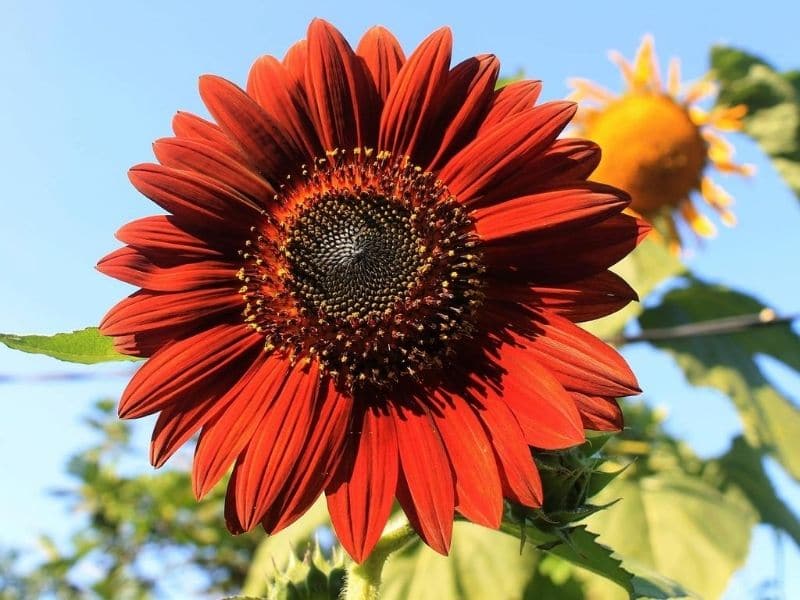
It has very bright and burnt orange blossoms, which is an excellent characteristic to have, especially if you want to welcome different pollinators. They can only grow up to four feet height; although, this can be great if you don’t have much space in your garden.
Sunbright Sunflower
Despite its name, this type of sunflower needs to be kept away from the strong afternoon sun. They will thrive best when there are shorter summer days, and when the temperature starts to cool down slightly. Please plant this sunflower behind sun-loving flowers or vegetables, such as daisies or even corn!
Sunrich Lime Sunflower
This sunflower has an attractive golden and lime look, making it completely different from other types of sunflowers. It is a hybrid plant, though it can be widely found in many areas of the world. They can reach full maturity in approximately 60 days after you plant them.
Russian Giant Sunflower
This is the biggest type of sunflower in the world. These giant sunflowers can grow up to 20 inches across and more than 12 feet in height! They have a single yellow flower, and it is the best type of sunflower to harvest its seeds from.
Helios Flame Sunflower
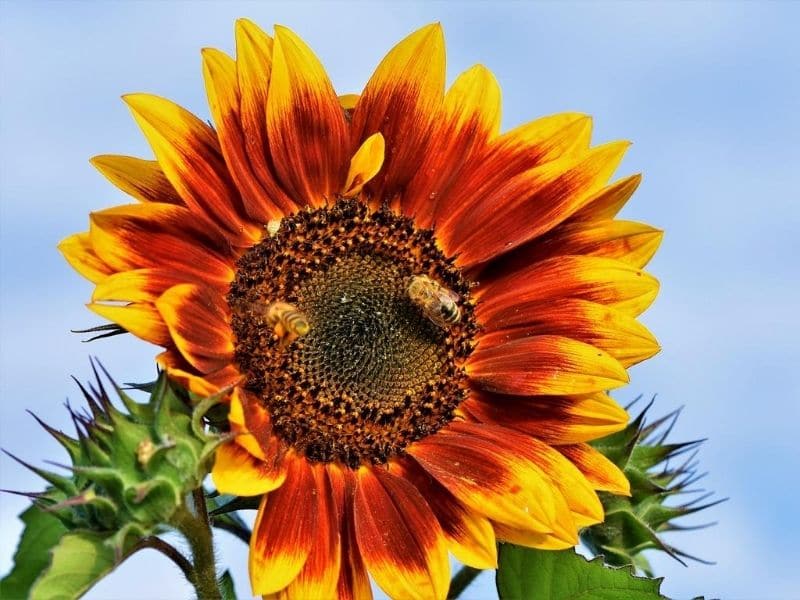
This type of sunflower will look amazing in any vase! They can reach up to six feet in height, and their blooms have a very subtle gold tone, which makes them look even brighter.
Star Sunflower
This is a very unique sunflower! It has fragile blooms, and it is definitely something you had never seen before! Unlike all other sunflowers, this plant’s center is entirely yellow as well!
ProCut Peach Sunflower
One of the loveliest sunflowers, it’s petals have a beautifully soft peach color; they are not well-known, although they are easy to grow! The procut peach sunflower needs well-drained soil, and they have pollen-free blooms so that they won’t attract as many pollinators to your garden.
Evening Sun Sunflower

This flower has different petal colors. Some may be gold, others red, and some others will be crimson. They can grow up to seven feet in height; they will reach full maturity and bloom in late summer until beginning of spring.
Dwarf sunflowers
Dwarf sunflowers (Helianthus annuus) are compact varieties, perfect for small gardens or containers. They produce cheerful blooms with classic sunflower faces on shorter stems, typically reaching heights of 1 to 2 feet.
Easy to grow, they thrive in full sun and well-drained soil, adding vibrant color to any space.
How To Grow and Care for Sunflowers
If you are seriously considering growing some sunflowers in your garden, this information will make your life easier (and it will make your ornamental flowers look better!):
Grow Sunflowers From Seeds

It would be best if you grew them from seeds. Once you know all danger of frost has passed and now the weather is warmer, then you can directly plant multiple seeds in your garden.
Alternatively, you could start indoors around four weeks before transplanting, when the weather is still cold, and your sunflowers need to be taken care of.
If you are starting your seedlings indoors, then I recommend you use paper pots or peat; this way, your sunflower won’t be damaged once you transplant it, as they have very sensitive roots.
Ideally, you could have a combination of indoor and outdoor seedlings; this way, you will make sure all of your seeds will sprout.
When growing outside, you will need to plant the seeds up to three inches deep and at least 12 inches apart; this way, your sunflowers will have enough space to thrive. If, on the other hand, you are planting the elf variety, then you could plant it one foot apart.
Also, growing sunflowers in well draining soil and fertile soil with organic matter is ideal. Place some compost on the soil in order to achieve this requirement.
Sunflowers’ Maintenance
Sunflowers hate weeds! They don’t like to compete against them, and even though they are large enough to block the sun (thus, most weeds won’t grow), there are still a few that will come up and could possibly damage your sunflower’s soil. This is why mulching your plants is so important, as it will help with weed suppression.
Once your sunflower starts to grow, you will see they tilt to one side more than the other. You could either plant sunflowers really close to one another (although you may suffer because of this later on) or stake them, so they support that instead.

Fertilizing sunflowers
Sunflowers need as much support as possible, mainly due to how fast they grow. It would be best if you prepare an organic fertilizer that is high in potassium and phosphorus.
You could do so by chopping banana skins tiny and thinly and then boil them with water and a tablespoon of sugar. Then, you can apply this homemade organic fertilizer into the soil where you have planted your sunflowers. Alternatively, you can always purchase slow-release fertilizer at your local nursery; just make sure they are organic!
Additionally, keep an eye out for yellow leaves or foliage turning yellow, as these can be signs of nutrient deficiencies or other stressors affecting your sunflowers.

Watering sunflowers
Sunflowers need a lot of water in order to thrive. When they are growing, make sure you water them each day. It is usual for sunflowers to stop blooming when there is a heatwave or long periods of drought.
Harvesting sunflowers
If you are planting sunflowers throughout the summer, you’ll be rewarded with an abundance of opportunities for harvesting sunflower seeds as soon as fall starts. However, you may also compete against other birds or pollinators who would love a snack!
It is essential to know when it’s the right time to harvest sunflower seeds. If you make a mistake, then your seeds will not be as good as they won’t have much ‘’meat’’; on the other hand, if you wait too long, then your seed will be too dry, and you will not be able to consume them.
So, when should you harvest the seeds? When you see the petals are becoming dry or when you see the first couple of petals on the ground. Keep an eye out for the flower heads showing signs of maturity.
You will then need to put them in a warm and ventilated place, so they can dry off completely before consuming them.

Sunflowers’ diseases and pests
Sunflowers can get fusarium, a very dangerous fungus that can only be found in your soil or your plants. Most sunflowers’ gardens will be affected by it at some point, although you can quickly remediate this if you make sure your soil is well-drained before you plant the seeds.
If you are a beginner gardener, then, did you know that squirrels love sunflowers? And yes, squirrels are too cute to be considered a pest, but if you ever see them eating away your beautiful sunflowers, you will want them to see them away from your garden! You can place some cloth netting in order to avoid squirrels and birds to eat away all of your plants.
Besides, you can also get some sunflower moths; they are known for laying their eggs on the sunflower, and then its larvae will start feeding off from the flower head. What’s worse, they will leave a big hole in the seed, so you won’t be able to consume them nor plant them again.
FAQs
Do sunflowers love full sun?
Yes, sunflowers thrive in full sun. They require at least 6 to 8 hours of direct sunlight each day to grow and develop properly.
Where do sunflowers grow best?
Sunflowers grow best in locations with plenty of sunlight, well-drained soil, and warm temperatures. They are native to North America but are cultivated in many regions around the world.
Do sunflowers face the sun all day?
While young sunflower buds may track the movement of the sun throughout the day in a behavior known as heliotropism, mature sunflowers typically face eastward and remain in that direction as they reach maturity.
How long do sunflowers last?
Sunflowers typically bloom for several weeks, with individual flowers lasting about one to two weeks before fading. However, the entire flowering period can vary depending on factors such as the variety of sunflower and growing conditions.
Why do sunflowers stop following the sun?
Sunflowers exhibit heliotropism, where young flower buds track the movement of the sun across the sky. However, once the flowers reach maturity, they typically face eastward and remain in that direction to maximize exposure to sunlight for seed production. This behavior may cease once the flowers have fully matured and begun to produce seeds.
Conclusion
As you can see, sunflowers not only look great, but they also have many benefits that will surely make you think ‘’I need to have some sunflowers in my garden now’’.
Like many kinds of flowers, not only are they good for the environment (because they will attract a wide range of pollinators), but they will also provide you with numerous ways of eating them, and, what’s more, they will even help your soil and water come back to life!
I dare say sunflowers are one of those plants that we should all cultivate, as the benefits of having and maintaining them surpass those negative aspects that may be associated with them (such as welcoming more rodents or animals into your garden).
You definitely need to consider having them in your home, especially if you are growing the other ‘’three sisters’’ such as beans, squash, and corn!
Up Next:
References
Reference List
Fernández-Luqueño, Fabián & López-Valdez, Fernando & Miranda-Arámbula, Mariana & Rosas-Morales, Minerva & Pariona, Nicolaza & Espinoza-Zapata, Roberto. (2014). An Introduction to the Sunflower Crop.
Kutschera, U., & Briggs, W. R. (2016). Phototropic solar tracking in sunflower plants: an integrative perspective. Annals of botany, 117(1), 1–8. https://doi.org/10.1093/aob/mcv141
Radanović, A., Miladinović, D., Cvejić, S., Jocković, M., & Jocić, S. (2018). Sunflower Genetics from Ancestors to Modern Hybrids-A Review. Genes, 9(11), 528. https://doi.org/10.3390/genes9110528
Close

